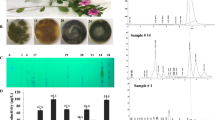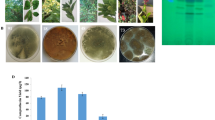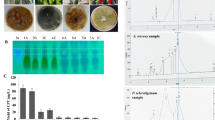Abstract
4-Acetylantroquinonol B (4-AAQB) was identified in the rare fungus Antrodia cinnamomea and has been proven to be a potential therapeutic agent for cancer treatment. But the extraction of 4-AAQB from the fruit body led to a low yield and limited its further application in the pharmaceutical field. In this work, 4-AAQB production was enhanced in the submerged fermentation by the combination of exogenous additives, surfactants with the in situ extractive fermentation. 4-Methylbenzoic acid was proven to be an efficient additive for the accumulation of 4-AAQB by Antrodia cinnamomea, while 2% (w/v) Tween-80 added on the first day as surfactant and 30% (w/v) oleic acid added on the sixteenth day as extractant were the most available couples for 4-AAQB production in the in situ extractive fermentation. The combination of these multiple strategies resulted in the yield of 4-AAQB to 17.27 mg/g dry cell weight with a titer of 140 mg/L, which was the highest titer of 4-AAQB reported so far. It showed that the combination of these strategies had a significant promotion on 4-AAQB production by A. cinnamomea, which laid a good foundation for its large-scale production and also provided a viable method for the cultivation of other rare fungi.




Similar content being viewed by others
Data Availability
Not applicable.
References
Hauner, K., Maisch, P., & Retz, M. (2017). Side effects of chemotherapy. Der Urologe. Ausg. A, 56, 472–479.
Chiang, C.-C., Huang, T.-N., Lin, Y.-W., Chen, K.-H., & Chiang, B.-H. (2013). Enhancement of 4-acetylantroquinonol B production by supplementation of its precursor during submerged fermentation of Antrodia cinnamomea. Jornal of Agricultura and Food Chemistry, 61, 9160–9165.
Chen, L., Wang, Z., Zhang, B., Ge, M., Ng, H., Niu, Y., & Liu, L. (2019). Production, structure and morphology of exopolysaccharides yielded by submerged fermentation of Antrodia cinnamomea. Carbohydrate Polymers, 205, 271–278.
Li, T.-Y., & Chiang, B.-H. (2019). 4-Acetylantroquinonol B from Antrodia cinnamomea enhances immune function of dendritic cells against liver cancer stem cells. Biomedicine & Pharmacotherapy, 109, 2262–2269.
Liu, Y.-M., Liu, Y.-K., Huang, P.-I., Tsai, T.-H., & Chen, Y.-J. (2018). Antrodia cinnamomea mycelial fermentation broth inhibits the epithelial-mesenchymal transition of human esophageal adenocarcinoma cancer cells. Food and Chemical Toxicology, 119, 380–386.
Chang, T.-C., Yeh, C.-T., Adebayo, B. O., Lin, Y.-C., Deng, L., Rao, Y. K., Huang, C.-C., Lee, W.-H., Wu, A. T., & Hsiao, M. (2015). 4-Acetylantroquinonol B inhibits colorectal cancer tumorigenesis and suppresses cancer stem-like phenotype. Toxicology and Applied Pharmacology, 288, 258–268.
Chang, C.-H., Hsu, C.-C., Lee, A.-S., Wang, S.-W., Lin, K.-T., Chang, W.-L., Peng, H.-C., Huang, W.-C., & Chung, C.-H. (2018). 4-Acetylantroquinonol B inhibits lipopolysaccharide-induced cytokine release and alleviates sepsis through of MAPK and NFκB suppression. BMC Complementary Alternative Medicine, 18, 108.
Lu, M.-C., El-Shazly, M., Wu, T.-Y., Du, Y.-C., Chang, T.-T., Chen, C.-F., Hsu, Y.-M., Lai, K.-H., Chiu, C.-P., & Chang, F.-R. (2013). Recent research and development of Antrodia cinnamomea. Pharmacology & Therapeutics, 139, 124–156.
Lin, T.-Y., Chen, C.-Y., Chien, S.-C., Hsiao, W.-W., Chu, F.-H., Li, W.-H., Lin, C.-C., Shaw, J.-F., & Wang, S.-Y. (2011). Metabolite profiles for Antrodia cinnamomea fruiting bodies harvested at different culture ages and from different wood substrates. Journal of Agricultural and Food Chemistry, 59, 7626–7635.
Zhang, B.-B., Guan, Y.-Y., Hu, P.-F., Chen, L., Xu, G.-R., Liu, L., & Cheung, P. C. (2019). Production of bioactive metabolites by submerged fermentation of the medicinal mushroom Antrodia cinnamomea: Recent advances and future development. Critical Reviews in Biotechnology, 39, 541–554.
Geng, Y., He, Z., Lu, Z.-M., Xu, H.-Y., Xu, G.-H., Shi, J.-S., & Xu, Z.-H. (2013). Antrodia camphorata ATCC 200183 sporulates asexually in submerged culture. Applied Microbiology and Biotechnology, 97, 2851–2858.
Li, H.-X., Lu, Z.-M., Geng, Y., Gong, J.-S., Zhang, X.-J., Shi, J.-S., Xu, Z.-H., & Ma, Y.-H. (2015). Efficient production of bioactive metabolites from Antrodia camphorata ATCC 200183 by asexual reproduction-based repeated batch fermentation. Bioresource Technology, 194, 334–343.
Shu, C.-H., Wu, H.-J., Ko, Y.-H., Lin, W.-H., & Jaiswal, R. (2016). Effects of red light and addition of monoterpenes and tangerine oil on the production of biomass and triterpenoids of Antrodia cinnamomea in submerged cultures. Journal of the Taiwan Institute of Chemical Engineers, 67, 140–147.
Chou, K.C.-C., Wu, H.-L., Lin, P.-Y., Yang, S.-H., Chang, T.-L., Sheu, F., Chen, K.-H., & Chiang, B.-H. (2019). 4-Hydroxybenzoic acid serves as an endogenous ring precursor for antroquinonol biosynthesis in Antrodia cinnamomea. Phytochemistry, 161, 97–106.
Yang, S.-H., Lin, Y.-W., & Chiang, B.-H. (2017). Biosynthesis of 4-acetylantroquinonol B in Antrodia cinnamomea via a pathway related to coenzyme Q synthesis. Biochemical Engineering Journal, 117, 23–29.
Chou, K.C.-C., Yang, S.-H., Wu, H.-L., Lin, P.-Y., Chang, T.-L., Sheu, F., Chen, K.-H., & Chiang, B.-H. (2017). Biosynthesis of antroquinonol and 4-acetylantroquinonol B via a polyketide pathway using orsellinic acid as a ring precursor in Antrodia cinnamomea. Journal of Agricultural and Food Chemistry, 65, 74–86.
Ooi, C. W., Hii, S. L., Kamal, S. M. M., Ariff, A., & Ling, T. C. (2011). Extractive fermentation using aqueous two-phase systems for integrated production and purification of extracellular lipase derived from Burkholderia pseudomallei. Process Biochemistry, 46, 68–73.
Pimentel, M. C. B., Araújo, A. I., Figueiredo, Z. M. B., Silva, R. A., Cavalcanti, M. T. H., Moreira, K. A., Filho, J. L. L., & Porto, A. L. F. (2013). Aqueous two-phase system for citrinin extraction from fermentation broth. Separation and Purification Technology, 110, 158–163.
Zhang, H., Xia, Y.-J., Wang, Y.-L., Zhang, B.-B., & Xu, G.-R. (2013). Coupling use of surfactant and in situ extractant for enhanced production of Antrodin C by submerged fermentation of Antrodia camphorata. Biochemical Engineering Journal, 79, 194–199.
Liu, X., Xia, Y., Zhang, Y., Yi, Z., Meng, P., Wang, G., & Ai, L. (2019). Enhancement of antroquinonol and antrodin C productions via in situ extractive fermentation of Antrodia camphorata S-29. Applied Microbiology and Biotechnology, 103, 8351–8361.
Liu, X.-F., Xia, Y.-J., Lai, P.F.-H., Zhang, Y., Yi, Z.-W., Xie, C.-L., Hong, Y.-Q., & Ai, L.-Z. (2020). An increase in cell membrane permeability in the in situ extractive fermentation improves the production of antroquinonol from Antrodia camphorata S-29. Journal of Industrial Microbiology & Biotechnology, 47, 197–207.
Ma, T.-W., Lai, Y., & Yang, F.-C. (2014). Enhanced production of triterpenoid in submerged cultures of Antrodia cinnamomea with the addition of citrus peel extract. Bioprocess and Biosystems Engineering, 37, 2251–2261.
Wei, Y.-Y., Chou, K.C.-C., Yang, S.-H., & Chiang, B.-H. (2020). Oxygen vector accelerates farnesylation and redox reaction to promote the biosynthesis of 4-acetylantroquinonol B and antroquinonol during submerged fermentation of Antrodia cinnamomea. Food and Bioproducts Processing, 120, 80–90.
Huang, X.-H., Chen, Q.-X., Wang, Q., Song, K.-K., Wang, J., Sha, L., & Guan, X. (2006). Inhibition of the activity of mushroom tyrosinase by alkylbenzoic acids. Food Chemistry, 94, 1–6.
Tran, U. C., & Clarke, C. F. (2007). Endogenous synthesis of coenzyme Q in eukaryotes. Mitochondrion, 7, S62–S71.
Krisch, J., Tserennadmid, R. & Vágvölgyi, C. (2011). Essential oils against yeasts and moulds causing food spoilage. Science against microbial pathogens: Communicating current research and technological advances. Badajoz, 3, 1135–1142.
Trivedi, M. K., Branton, A., Trivedi, D., Nayak, G., Singh, R., & Jana, S. (2015). Physicochemical and spectral characterization of biofield energy treated 4-methylbenzoic acid. American Journal of Chemical Engineering, 3, 99–106.
Zhang, B.-B., Chen, L., & Cheung, P. C. K. (2012). Proteomic insights into the stimulatory effect of Tween 80 on mycelial growth and exopolysaccharide production of an edible mushroom Pleurotus tuber-regium. Biotechnology Letters, 34, 1863–1867.
Wei, G., Li, Y., Du, G., & Chen, J. (2003). Effect of surfactants on extracellular accumulation of glutathione by Saccharomyces cerevisiae. Process Biochemistry, 38, 1133–1138.
Marques, D. d. A. V., Torres, B. R., Porto, A. L. F., Pessoa-Júnior, A. and Converti, A. (2009). Comparison of oxygen mass transfer coefficient in simple and extractive fermentation systems. Biochemical Engineering Journal 47, 122–126
Tian, W., Yao, J., Liu, R., Zhu, M., Wang, F., Wu, X., & Liu, H. (2016). Effect of natural and synthetic surfactants on crude oil biodegradation by indigenous strains. Ecotoxicology and Environmental Safety, 129, 171–179.
Liu, X., Xu, J., Xia, J., Lv, J., Wu, Z., & Deng, Y. (2016). Improved production of citric acid by Yarrowia lipolytica using oleic acid as the oxygen-vector and co-substrate. Engineering in Life Sciences, 16, 424–431.
Funding
This research was financially supported by the National Key Research Program (2016YFD0400601, 2017YFB03069043), the Hong Kong, Macao and Taiwan Scientific and Technological Cooperation Projects (2015DFT30050), and National Natural Science Foundation of China (21978019, 21978020).
Author information
Authors and Affiliations
Contributions
Huan Liu and Li Deng conceived the topic and designed the study. Huan Liu: data curation, investigation, methodology, writing original draft; Hao Xing, Yuhan Jin, and Jie Liu: data curation, investigation, methodology; Yew-Min Tzeng, Li Deng, and Fang Wang: writing—review and editing, supervision, funding acquisition, conceptualization, project administration.
Corresponding author
Ethics declarations
Ethics Approval
Not applicable.
Consent to Participate/Consent for Publication
Not applicable.
Competing Interests
The authors declare no competing interests.
Additional information
Publisher's Note
Springer Nature remains neutral with regard to jurisdictional claims in published maps and institutional affiliations.
Highlights
• 4-MBA was proven to be an efficient exogenous additive for 4-AAQB production.
• The in situ extraction method was applied in 4-AAQB production by A. cinnamomea.
• The addition of surfactants was proven to be beneficial for 4-AAQB production.
• Combining these multiple strategies resulted in 17.27 mg/g 4-AAQB produced.
Supplementary Information
Below is the link to the electronic supplementary material.
Rights and permissions
About this article
Cite this article
Liu, H., Xing, H., Jin, Y. et al. Application of Multiple Strategies to Improve the Production of the Potential Cancer Drug 4-Acetylantroquinonol B (4-AAQB) by the Rare Fungus Antrodia cinnamomea. Appl Biochem Biotechnol 194, 2720–2730 (2022). https://doi.org/10.1007/s12010-022-03811-0
Accepted:
Published:
Issue Date:
DOI: https://doi.org/10.1007/s12010-022-03811-0




